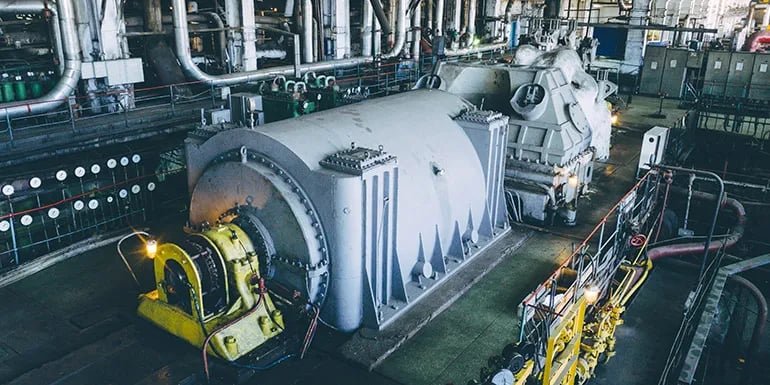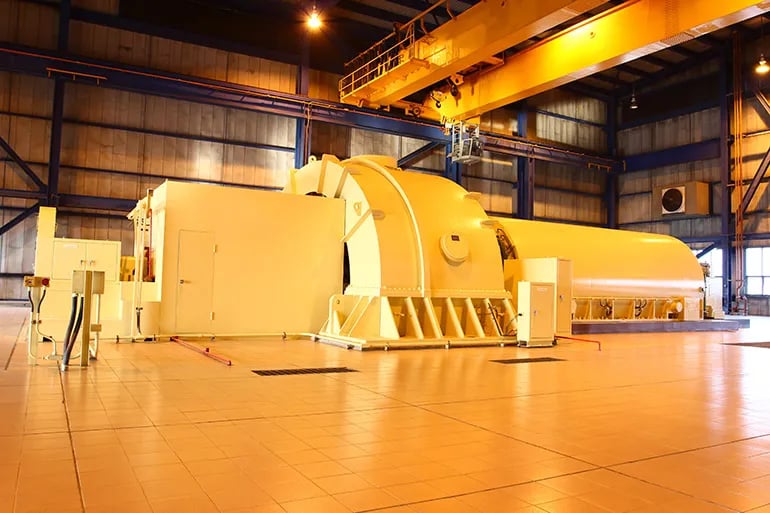The Importance of Steam Turbine Maintenance
Regular maintenance is a crucial factor in maintaining the efficiency of steam turbines. When maintenance is neglected, turbines can suffer from a variety of issues that significantly reduce their efficiency. These include the buildup of deposits on turbine blades, wear and tear on moving parts, and misalignment of components, all of which can lead to increased fuel consumption and reduced output.
Maintenance plays a key role in adapting to changing operational conditions. For instance, turbines may need adjustments or recalibrations as they age or as the operational environment changes. Regular maintenance provides opportunities to make these adjustments, ensuring that the turbine continues to operate efficiently under new conditions.
How to Complete Proper Steam Turbine Maintenance
Effective maintenance includes regular inspections, cleaning, and timely replacement of worn parts. These actions ensure that the turbine operates smoothly, with minimal friction and resistance, thus maintaining optimal efficiency. Regular maintenance also allows for the early detection of potential issues. This enables repairs to be made before they become major problems. This proactive approach not only keeps the turbine running at peak efficiency but also avoids the costly downtime that comes with major repairs or breakdowns.
How to Improve Steam Turbine Efficiency
This complex task involves a series of planned and preventive activities, such as inspections, cleaning, lubrication, part replacements and more.
- Regular Inspections: Conduct thorough inspections of the turbine's components to identify any signs of wear, misalignment, or damage. This helps in early detection of issues.
- Cleaning: Regularly clean turbine blades and other components to remove deposits and prevent buildup, which can hinder efficiency and lead to increased fuel consumption.
- Replacement of Worn Parts: Timely replace parts that show signs of wear to prevent malfunctions and maintain smooth operation of the turbine. Common examples include blades, turbine rings, and bearings.
- Lubrication: Ensure proper lubrication of moving parts to reduce friction, prevent overheating, and maintain efficient operation.
- Performance Monitoring: Continuously monitor the turbine’s performance to detect any deviations from normal operation, allowing for prompt corrective actions.
- Calibration and Adjustments: Regularly calibrate and adjust the turbine to adapt to changing operational conditions and ensure optimal efficiency.
Key Factors That Affect Steam Turbine Efficiency>
There are various factors that significantly impact the efficiency of steam turbines. Understanding these elements is crucial for effective maintenance and operation:
- Wear and Tear: Continuous operation leads to wear and tear of turbine components, affecting efficiency. Regular inspections and maintenance are essential to address this issue.
- Blade Cleanliness: The accumulation of deposits on turbine blades can greatly reduce efficiency. Keeping blades clean ensures optimal aerodynamic performance.
- Steam Quality: The quality of steam, including its temperature and pressure, plays a vital role in turbine efficiency. Any deviations can lead to inefficiencies.
- Alignment and Balancing: Proper alignment and balancing of the turbine are critical. Misalignments or imbalances can cause vibrations and increased wear, reducing efficiency.
- Lubrication: Adequate lubrication reduces friction in moving parts, contributing to smoother operation and higher efficiency.
- Control Systems: Modern control systems can optimize turbine performance, but they need to be properly calibrated and maintained.
- Environmental Conditions: External factors like ambient temperature and humidity can also affect the performance of steam turbines.
Each of these factors requires careful consideration and regular monitoring to ensure that the steam turbine operates at its highest efficiency. Maintenance strategies should be tailored to address these specific aspects. This ensures the long-term health and efficiency of the turbine.
Comparing Steam Turbines vs Gas Turbines
Steam and gas turbines have a few notable differences. Steam turbines often operate at higher efficiencies due to their ability to work under conditions of greater pressure and temperature.
Gas turbines incorporate elements like compressors and combustion chambers. This causes them to be more economical in terms of space and installation costs. On the other hand, steam turbines use components such as steam boilers and heat exchangers. This generally leads to larger space requirements and increased operational expenses.
How Can St. Marys Carbon Help with Turbine Efficiency?
Our HALO™ turbine and compressor rings, crafted from high-quality carbon graphite grades, are essential in boosting the efficiency of steam turbines. Their standout features include remarkable high-temperature stability and minimal friction/wear, thanks to their self-lubricating nature. These characteristics greatly diminish the likelihood of failures and enable their use across diverse environments.
Our carbon graphite compressor rings find applications in a broad spectrum of products and markets, showcasing their versatility. Additionally, we offer customization options to tailor these rings to meet the specific needs of various applications, ensuring they align perfectly with the unique requirements of different industrial uses.

FAQs about Steam Turbine Maintenance
How often should steam turbines be serviced?
Steam turbines should typically be serviced annually. The exact frequency depends on operational hours, the type of turbine, and manufacturer recommendations. Regular monitoring helps in scheduling maintenance more effectively.
What are the signs that a steam turbine needs maintenance?
Indicators include a noticeable drop in efficiency, unusual sounds during operation, increased vibration, and visible wear or damage to components.
Can regular maintenance extend the life of a steam turbine?
Yes, consistent and proper maintenance significantly extends the operational life of a steam turbine and helps maintain its efficiency and reliability.
Wrapping Up - Maximizing Efficiency with Proper Steam Turbine Maintenance
The maintenance of steam turbines is a crucial aspect that directly influences their efficiency, operational life, and overall performance. Understanding the importance of regular servicing, recognizing the signs of needed maintenance, and addressing specific requirements based on turbine type are key to ensuring their optimal functioning. Regular maintenance not only extends the lifespan of these turbines but also ensures they operate at peak efficiency. This contributes to cost-effectiveness and reliability in power generation. By adhering to these maintenance practices, operators can significantly enhance the performance and longevity of their steam turbines.
The use of advanced components and carbon graphite grades in our HALO™ turbine & compressor rings further enhances this efficiency. By considering these aspects and implementing thorough maintenance practices, operators can significantly improve the performance and lifespa, and safety of steam turbines.



